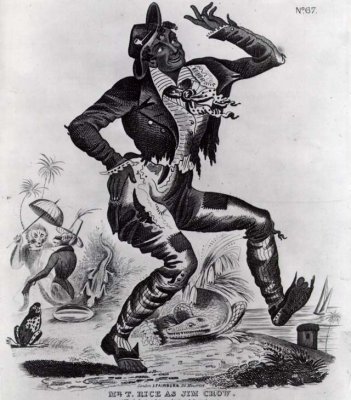The earliest reference to the name ‘Jim Crow’ that I have found was by Edward Stone Parker in his report of September 22nd 18391. In John Tully’s book of the Djadja Wurrung Language2, he states that Jim Crow is a corruption of jumcra, the aboriginal name for the area. I have not discovered an original source for the corruption ‘Jim Crow’. It is unlikely that Parker coined the corruption because he was familiar with aboriginal names and referred to them regularly in his writings.
‘Jim Crow’ would have been a familiar phrase at that time, and least to those who had knowledge of North America or English theatre as explained below…
(Thanks to Bill McClenaghan for his contribution to the following section)

Thomas D. Rice as ‘Jim Crow’, 1832
“Jim Crow” was a stage character created in 1828 by a travelling white minstrel called Thomas “Daddy” Rice, who used to blacken his face (as Al Jolson did a century later). By 1830 the “Jim Crow” character had become his signature act. Rice was very popular and toured extensively in North America. He was known in England too. He was mentioned in the Times in 1833, he toured England in 1836 and married there in 18373.
Why Rice chose that name is the subject of debate and nobody knows for sure; perhaps the name of an old black slave or a ragged black stable boy. In any case, it became synonymous with black Americans and other racial groups considered inferior at the time in American society. Decades later, segregation laws would become known as the “Jim Crow Laws”.
So it is likely that any English settlers in the Colony who had been to the theatre back home would know of the character “Jim Crow” and would associate the phrase with black people. Upon hearing the local Aborigines use the term jumcra, one can speculate how they might easily arrive at the corruption “Jim Crow”.
I have just found some information (from Ballarat Genealogy) that claims two of Alexander Mollison’s shepherds coined the name ‘Jim Crow’ when they established a western extension of Mollison’s run in 1840, further that Mollison wanted to change the name to ‘jumcra’. But then according to Edgar Morrison’s book, Parker referred to the name in 1839. Maybe some of these dates are a bit fuzzy. I will try to verify the original source and date of this information. The Ballarat Genealogy page states as follows:
“Alexander Mollison, in a letter to his sister Jane on April 30th 1840 tells of the naming.
“One of my finest sheep runs is nicknamed ‘Jim Crow’ and a young settler, not very refined in his ideas, and who stutters painfully, amuses me when I chance to meet him, he pertinaciously reporting ‘Ah it was m-m-m-m-me that called it J-J-J-Jim Crow’. I have Australianised it into Jumcra but with little effect.” 4
Update 17th July 2019
There has more recently been controversy as to which name came first: ‘Jim Crow’ or ‘Jumcra’? That is, it could be that ‘Jumcra’ is an aboriginal corruption of ‘Jim Crow’. In John Tully’s 1997 book2, John gives ‘Jumcra’ as the aboriginal name, however, following a recent personal contact with John Tully, he provided the following, indicating his opinion has changed since the 1997 book:
“Since writing the language book in 1997 I learnt more about linguistics and have more references. In my 2016 book I had trouble deciding whether Jim Crow was named after Jumcra or the other way round. I concluded Jumcra is probably not a traditional name. The Mollison reference changes things again. The name early on was recorded by Parker, Hepburn and Mollison in three different places. This leans more to the European origin as Aborigines didn’t usually name creeks but individual names for camping places along a creek. This is not conclusive. Jumcra is not a typical Djadja wurrung word which suggests it to be a corruption of Jim Crow rather than a traditional name. In conclusion it is not certain which name came first. Also I don’t think we can be certain whether the original names Jim Crow or Jumcra referred to the creek or the range.” [John Tully].
References
1. cited on p26 of: Morrison, Edgar & Morrison, Geoff (ed.) 2002 A Successful Failure, a Trilogy : The Aborigines and Early Settlers Graffiti Publications for the publisher Geoff Morrison, Castlemaine, Vic
2. Tully, John 1997 Djadja Wurrung language of Central Victoria : Including Place Names John Tully, Dunolly, Vic.
3. Thomas D. Rice – Wikipedia, the free encyclopedia. Available at: http://en.wikipedia.org/wiki/Thomas_D._Rice [Accessed September 30, 2010].
4. central vic squatters. Available at: http://www.ballaratgenealogy.org.au/art/loddon.htm [Accessed October 12, 2010].






Some corroboration from ANU:
See paragraph “16. Jim Crow Hill” here:
http://press.anu.edu.au/apps/bookworm/view/Indigenous+and+Minority+Placenames+Australian+and+International+Perspectives/11111/ch14.xhtml
The Ballarat Genealogy link is now broken. I have found a reference to the letter at: http://trove.nla.gov.au/ndp/del/article/971080
“One of my finest sheep runs is nick-named ‘Jim Crow,’ and a young settler not very refined in his ideas and who stutters painfully, amused me when I chanced to meet him, by repeating, ‘Ah, it was m-m-me that called it J-J-J-Jim Crow.’ I have Australianised it Jumcra, but with little effect.”
This is interesting because here we have reference to both ‘Jim Crow’ and ‘Jumcra’ in the same text, at about the time when the name was coined.